|
For researchers these
three volumes will be a gold mine of information especially through
the Restoration period of our history. I am making these volumes
available at the foot of the page but have ocr'd in the Preface for
you to read here.
PREFACE
The Lauderdale MSS.
preserved in the British Museum, so far as they are concerned with
the period succeeding the Restoration, are contained in thirty-six
volumes (Add. MSS. 23,113—23,138, and 23,242—23,251, inclusive),
each volume holding, on a rough average, from 100 to 150 documents.
They cover the whole of Lauderdale’s administration, and they
contain, moreover, a few letters prior to 1660 of great interest.
There are also several other volumes (Add. MSS. 22,878 and
23,108—23,112, inclusive) containing papers of an earlier date, many
of them relating especially to William Maitland of Lethington,
Secretary to Mary Queen of Scots. To these, however, 1 have at
present given no attention.
It is obvious that, even with the space so generously accorded to me
by the Society, I can present but a meagre selection from a mass of
documents of which there are but very few that do not possess
something of real importance. The principles which have guided me
have been, in the first place, to afford the material most necessary
for the student of Scottish history during the Restoration period;
and, secondly, to illustrate fully the career and the character of
any person of importance, especially if such career and character
have hitherto been in dispute—e.g., Lauderdale and James Sharp. A
few letters of isolated interest are also included.
I am painfully conscious of the imperfections that will be noticed
in the present volume: the distance of my residence from London, the
small amount of time which the unfrequent intervals of official
employment have enabled me to devote to the work, and previous
inexperience, have all contributed to the imperfections. The effects
of the last cause, however, have been minimised by the generous help
which has been given to me, as it is given to others, by Mr. E.
Maunde Thompson and Mr. E. J. L. Scott, of the MSS. department, the
latter of whom has supervised the accurate chronological arrangement
of the papers, without which the task of selection would have been
well-nigh impossible. To Mr. H. J. Ellis, who probably knows more
about these MSS. than any one else, and who has undertaken the
labour of furnishing me with transcripts, I am in a special degree
indebted for continual assistance in all matters of difficulty. It .
is to him that I owe the following interesting particulars regarding
the sources from which the Lauderdale papers have been obtained. He
says:—
“I think there is no doubt that they were all formerly at Ham House,
near Richmond. Elizabeth, Countess of Dysart, the Duke’s second
wife, inherited the house and lived there; as also did her
descendant, Louisa, second Countess of Dysart, who died 22nd
September, 1840. It was during the occupancy of Countess Louisa that
most, if not all, of the papers were removed. A large number which
found their way into the hands of Dawson Turner, of Great Yarmouth,
were bought, at the sale of his library in 1859, by the British
Museum, and became Add. MSS. 22,878, 22,922, 23,108—23,125, Add.
Charters 14,503—14,508,Ify. MS. 1818. The history of this portion is
curious. Hudson Gurney, in a letter to Sir H. Ellis from Keswick in
1852, says that * the Scottish Papers in Dawson Turner’s possession
were abstracted from Ham House by a waiting-woman of old Lady
Dysart’s, during her courtship by a very well informed Antiquary ’
(who this may be, I know not), ‘ who married her, and many years ago
I spoke to George Sinclair of several of them having been seen in
these parts (supposing they had been taken from Helmingham). He said
that perhaps their preservation would be best secured by getting
into the collection of some one who would value them, hut spoke of
them to the old lady, who gave all the remaining ones, as I have
understood, to him, and he deposited them in the Advocates1 Library
at Edinburgh. The history of a part of them is curious. Evelyn
complained of having lent them to the Duke of Lauderdale and never
having been able to get them back again.’ *
“The papers mentioned above by Gurney as given to George Sinclair
(who became Sir G. Sinclair, Bart, of Ulbster, in 1835, and had
married the Countess’s granddaughter in 1816) were sold by him to
the Bannatyne Club in 1830, or later, and by the Bannatyne Club in
turn to the British Museum in 1859, when they became Add. MSS.
23,126—23,138. A number of letters by Lady Margaret Kennedy, the
Earl of Argyll, and others, which originally were in this portion of
the papers, were printed for the Bannatyne Club in 1828 and 1829,
and the originals of these are, or were to be, deposited in the
Advocates’ Library. As far as I can ascertain, these papers are not
now forthcoming at that library.
“Another large portion of the papers, perhaps containing the most
important of all, relating to the Billeting Act, &c. were purchased
from a Miss Ryder in 1859-60, and were numbered Add. MSS.
23,242—23,251. I cannot trace the history of this portion, but I
expect that they formed a part of those abstracted from Ham House.
They were not in Dawson Turner’s hands at any time that I can trace.
A few of the papers dispersed at Turner’s sale in 1859 have since
found their way to the Museum, such as those in Add* MS. 28,747, and
others, but most have been lost sight of, such as—MSS. and printed
papers on the charge of Treason against Argyll in 1661, including
original petitions, &c.—Lauderdale’s Household expenses at
Thirlestane, 1678—The Catalogue of his Library, 1646?—Sir Robert
Moray’s letters to Lord Kincardine, 1654-1674, copies.—Letters of
Scottish advocates, 170 in number, from 1660 onwards (a companion
volume came to the Museum at the sale)—A volume containing 82
letters of Archbishop Sharp and 46 of Archbishop Alexander Burnet,
1660-1681 (this was purchased for the Duke of Newcastle)—Papers
relating to Archbishop Sharp’s murder, 1679-80—besides many single
letters and papers.”
Through the courtesy of the Librarian of the University Library,
Edinburgh, I am enabled to state that there are preserved in that
library eight volumes of transcripts of letters from Lauderdale to
the Earl of Rothes between 1665 and 1668 ; but the whereabouts of
the originals I am unable to ascertain.
I have also to express my thanks to Mr. T. Dickson, of the Registry
House, Edinburgh, for his kindness in supplying me with much useful
information. (See, especially, notes on pp. 9, 225, 272.)
The present volume contains a view of Scottish history from 1660
until Lauderdale’s first visit as High Commissioner in 1669, or,
rather, until Robert Moray’s arrival in Scotland as his forerunner.
There were, however, a few papers of special interest, prior to the
Restoration, which could not be omitted. The most curious of these
(p. 2), the draft of the secret conditions between Cbarles and the
Scotch nobles at the Isle of Wight, has already been printed (Athenceum,
Jan. 26, 1878) by Mr. Scott. It will be observed that the Kirk, in
whose name the Commissioners were virtually treating, is not even
mentioned, a fact that will excite no astonishment among those who
are acquainted with the hatred of the nobles to the Presbyterian
yoke from the first success of the Scottish Reformation. A similar
omission will be noticed in the private letter (p. 6) written in an
early month of 1660 by Lauderdale, Crawford, and Sinclair, to
friends in Scotland. It is valuable as giving full expression to the
views of the u Engagement” Nobles who, after the Act of Classes, had
formed the National party. It will be observed that the Restoration
is spoken of as implying immediate disconnection from England. It
shows, too, how the. Scotch nobles were all pressing forward to
obtain a good start in the struggle for office and plunder which
they hoped was about to begin. The urgent advice “ to banish all
designs or indeavors for places or imployments,” as coming from the
writers, can, perhaps, scarcely be regarded as disinterested.
Another of these letters, to which I would call particular
attention, is that from Robert Moray to Lauderdale in June 1660, (p.
28), from which it appears that Moray’s mission in France was to
secure from the French Presbyterians a judgment in favour of
Episcopacy, a mission in which he was completely successful.
The Billeting Act, the clumsy effort made by Middleton, the High
Commissioner, and his faction, to oust Lauderdale from the
Secretaryship, which he had cunningly secured, receives full
illustration (pp. 106-134) from the letters written to the latter by
William Sharp, his private agent, brother to the Archbishop. They
are, for the most part, in sympathetic ink, and it was only with
considerable difficulty that they could be deciphered. They will be
found to correct one or two of the statements of Burnet on the
subject. The interpretation of the names under which William Sharp
represented the persons most concerned, e.g. “ Hastie,’ u Sheldon,”
“ Nothing,” i€ Mr. Smith,” &c. caused considerable difficulty, but
is, I believe, in each case fully established. The u person of Flisk,”
who is mentioned on p. 113, and who occurs
several times later, as well as in James Sharp’s letter on p. 45,1
have, since the letters were printed, proved to my satisfaction to
be the Earl of Rothes. Flisk is a small village, five miles
north-west of Cupar. The ancestors of the Rothes family acquired it
about 1320, and it remained with them for 500 years.
To all to whom the character of James Sharp is still a matter of
solicitude, the long series of letters (pp. 24-97) from him,
addressed chiefly to Patrick Drummond, a London Presbyterian
minister, who was in communication with Lauderdale, will give great
assistance. It will be observed that, from p. 60 to p. 90, Sharp’s
letters contain various marginal marks, evidently placed there in
order to call attention to special passages. From these marks, and
from a general consideration of the contents, I have little doubt
that these are the very letters which, as Burnet tells us,
Lauderdale laid before Charles II., when it suited his object to
expose Sharp’s meanness and insincerity. I would call especial
attention also to Letter xxix. (p. 56), from James Sharp, already
printed by Mr. Scott in the Atherueum. It is a mutilated fragment;
but it was evidently written to Lauderdale, and sent to him direct.
The variation-in tone between this letter and those sent through
Drummond is worthy of notice. A careful perusal of the whole series,
and of others which I hope to include in a second volume, will save
any future biographer from the temptation of endeavouring to
palliate a life of petty meanness such as has seldom been exceeded
in history. In the most comprehensive sense of the word Sharp was a
knave, pur sang, and one who, to retain the price of his knavery,
eagerly submitted to be cajoled, threatened, bullied, or ignored, by
bolder men as served their turn. I have been careful to include
everything of Sharp’s in my collection. Several of the letters
mentioned will be found quoted at length in Mr. Burton’s History of
Scotland. The correspondence between Lauderdale and Robert Moray
(pp. 135-190), when the former went down to Scotland after
Middleton’s disgrace in 1663, apart from the vivid accounts which it
gives of Warriston’s trial and the revenge of Lauderdale upon the
defeated faction, illustrates how completely, in opposition to
Clarendon and Monk, the Secretary had succeeded in confining the
conduct of Scotch affairs to three persons—the King, Moray, and
himself (see, for one example out of many, a sentence in the middle
of p. 182, and the first sentence in Lauderdale’s letter to Charles
on p. 184);—and how entirely he is to be regarded, not as the
minister of a constitutional king, but as the grand vizier of an
irresponsible despot. The frequent notices, too, of Charles’ habits
and ways of speech; of his remarkable bodily energy; of his
repugnance to steady work; of his ability in dealing with
disagreeable business that had to be got through; are given by Moray
with great spirit. For my estimate of the characters of Lauderdale
and Moray, as for a somewhat detailed account of the bearing of
these MSS. upon the history of the government of Scotland during
this period, I may be permitted to refer to my article in the
Quarterly Review for April, 1884.
The second portion of this volume (pp. 191-283) illustrates the
reign of violence and avarice which, under Rothes and James Sharp,
in league with Hamilton, Dalyell, and others of the needy nobility,
led to the Pentland Rebellion, and to the horrors of its
suppression. Two points in especial are brought prominently before
us; the entire absence of sympathy between the nobles and the
classes below them ; and the apparently universal hatred of the
English. The latter feeling was, of course, the result in a great
measure of the jealousy of England, which effectually strangled the
cattle and com trades in Scotland. It reached its height when the
war with Holland closed the only remaining market for Scotch
merchandise. So bitterly was this felt that there is little doubt
that a successful landing of the Dutch would have been followed by
an immediate rising of the western shires. This point will be found
fully illustrated in the letters selected, as well as in the letters
of Sharp and Alexander Burnet to Sheldon contained in the Sheldon
MSS. in the Bodleian Library. Of the rout of Pentland an eyewitness
account from Charles Maitland, Lauderdale’s brother, will be found
on p. 248. As regards the numbers of the rebels and their equipment
it is, I imagine, quite untrustworthy.
Lauderdale’s chief correspondent during this period is Rothes, who
had been his devoted friend, and who had been made Commissioner upon
Middleton's disgrace, as a useful tool in the Secretary’s hands.
Tweeddale, whose son married Lauderdale’s daughter, and Bellenden,
also send letters full of interest. With Rothes, extortion appears
to have been the only object, and brutality the only method.
Hamilton, Dalyell, and Drummond were of one mind with him. Sharp,
partly from spite against the adherents of the Kirk which he had
betrayed, partly out of a desire, natural to his base temper, to
plot against the hand that had raised him, and Burnet the Archbishop
of Glasgow, out of real honest bigotry, joined the Holy Alliance,
which had for its object the maintenance of military rule, the
unflagging suppression of all opposition to the Episcopal Church,
and the establishment of an influence independent of the Secretary.
With what admirable knowledge of the men with whom he had to deal
with what perfect temper, courage, confidence, and unscrupulousness,
Lauderdale, with the invaluable aid of Moray and Tweeddale, broke up
this alliance, when the disorder which it produced began to threaten
his credit and power, will appear from the documents to be printed
in the next volume.
The Appendix contains some letters accidentally omitted, with one of
James Sharp from Add. MS. 4162, f. 46, which is included as being
the earliest communication I have found from him to Lauderdale. I
regret that through an oversight a few letters have been printed
which appear in Wodrow, e. g. those on pp. 99-103, referring to
Tweeddale’s commitment and release.
Errors and omissions occur in the notes, which it has been
impossible to correct or supply, as they were not discovered until
after the sheets had been printed off. On p. 148, for instance, “
Cassilis” should be “ Dunfermline ”; on p. 181, the reference
23,119, f. 105, should be 23,119, f. 159; the suggestion “Fletcher/’
on p. 115, should no doubt be “ Flisk.*’ “ Lauderdale’s Kinsman ”
mentioned on p. 224 was Athol. The tavern spoken of on p. 139 as the
place where the Billeting plot was matured was Masterton’s Tavern.
The references at the headings of the letters, e.g. 23,113, f. 5,
are to the Adi. MSS.
To any one who undertakes the close examination of so large a body
of MSS., the character of the handwriting is a matter of no little
importance. It is curious how closely, in several of the instances
contained in this volume, it reflects the character of the writer.
That of James Sharp, for example, is small, paltry, niggling, and
exceptionally annoying; the style is self-conceited and pedantic.
Rothes writes like an illiterate boor, barely able to do more than
make his mark; each letter is formed singly, and the distance
between the several letters of a word is often as great as that
between the words themselves. The spelling is equally rudimentary;
and, though leading principles of interpretation gradually developed
themselves as I read, reason had frequently to be supplemented by
daring. Thus, when Rothes' prides himself on his attendance to
business, in that he held a Council although it was “couppereas
day,” it is pretty certain that he meant “Cupar Race day”; but this
is a comparatively simple case. Dalyell’s spelling and language are,
perhaps, still more barbarous and uncouth. Lauderdale himself writes
a bold, rather coarse and slovenly hand, easy to read, as his
meaning is always easy to understand ; the masterful and somewhat
brutal bonhomie of the man comes out strongly in style and language.
Robert Morals writing is that of a scholar; it is a.beautiful modern
hand, almost too facile for perfect ease of reading. He is often
lengthy, but always clear, and never wearisome. Tweeddale is the
most legible of all; his style of narrative, however, is, on the
whole, tedious, and his pleasantry somewhat clumsy.
I have, in conclusion, to express my regret at the delay which has
taken place in the issue of this volume, a delay caused entirely by
a somewhat prolonged illness.
Osmund Airy.
Birmingham.
April 28th, 1881.
Volume 1
|
Volume 2 |
Volume 3
I have scanned in the
first 5 pages to give a flavour of the content.
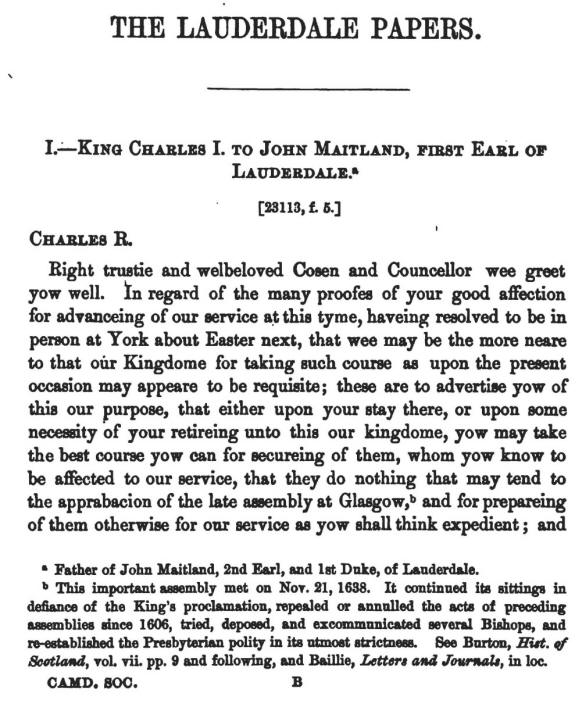
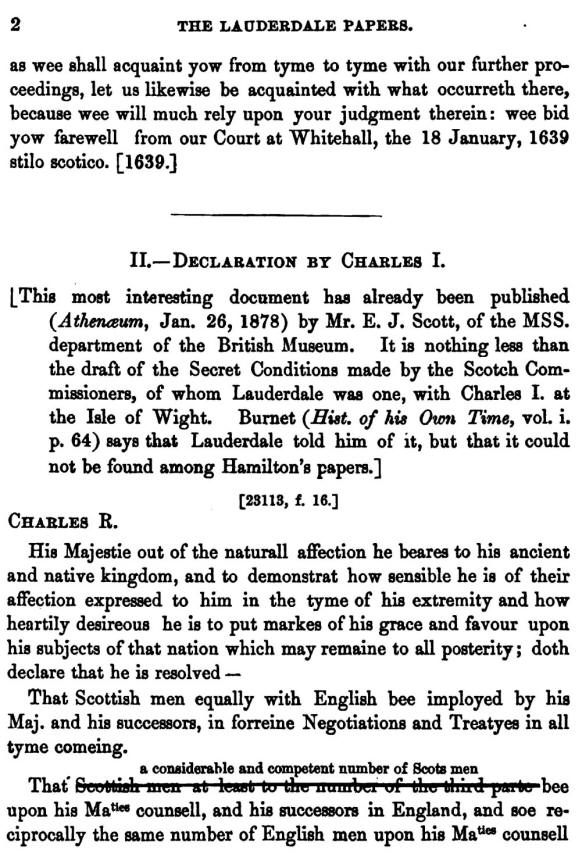
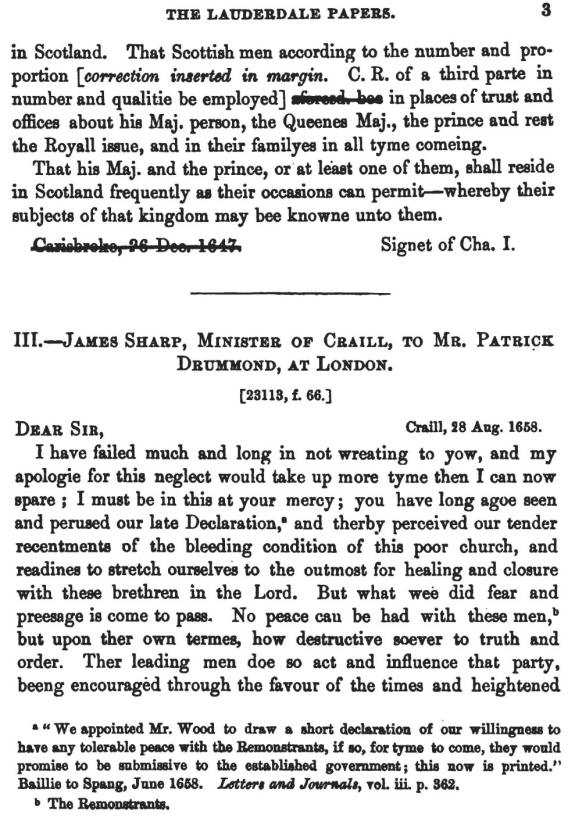
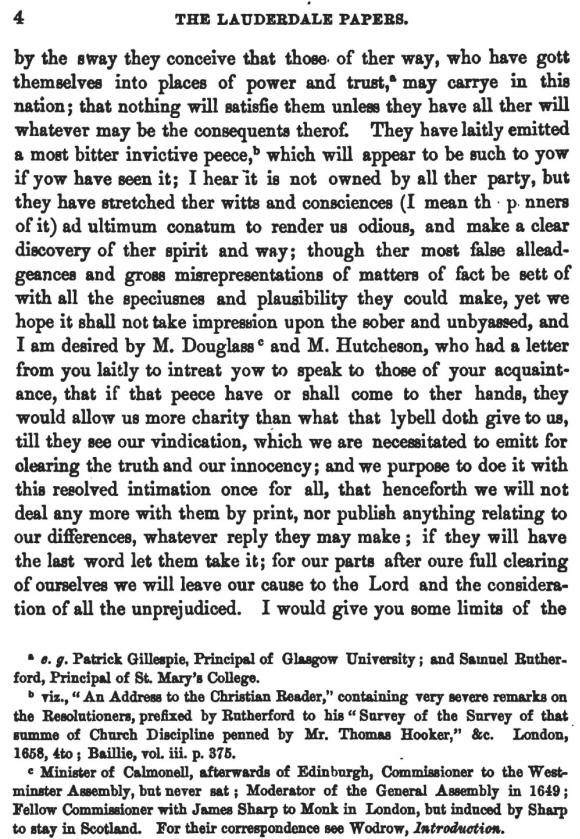
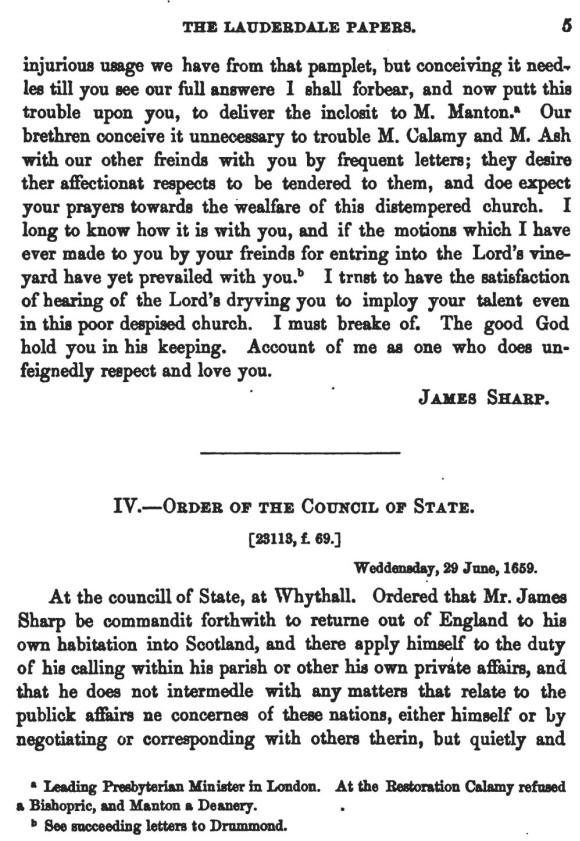 |

